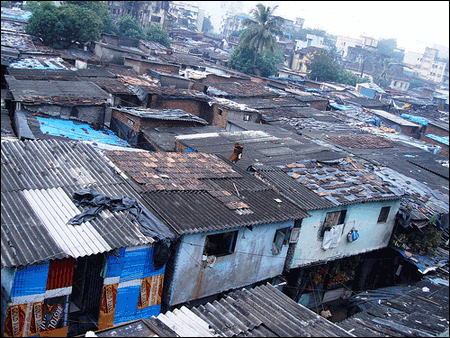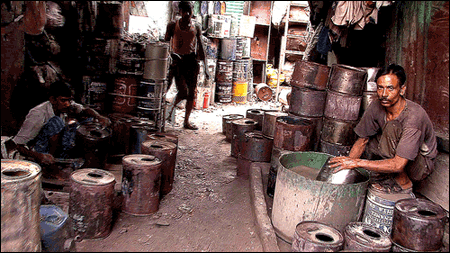Mumbai, India's Dharavi is one of the world's biggest slums -- and its most notorious. Look beyond the stereotype, however, and you'll find a successful settlement with a vibrant community and economy. But developers want to raze it all and start again. Urban development consultant Prakash M. Apte says Dharavi is a model that should be replicated, not redeveloped.
 The Indian megacity of Mumbai has an estimated population of about 14 million. Of those, only about 35% live in 'regular' permanent housing. The other 65% live in informal settlements, which for more than a third of those people means squatting on sidewalks and under bridges. The rest -- nearly 6 million people -- occupy settlements on private and public open lands, some of which are more than 50 years old. Dharavi is one of the most famous, but unlike all others and despite its common depiction as a "slum", it is actually a successful work-cum-residential settlement. Developers have been trying to redevelop the area for years, but Dharavi is a model settlement that needs to be replicated, not replaced.
The Indian megacity of Mumbai has an estimated population of about 14 million. Of those, only about 35% live in 'regular' permanent housing. The other 65% live in informal settlements, which for more than a third of those people means squatting on sidewalks and under bridges. The rest -- nearly 6 million people -- occupy settlements on private and public open lands, some of which are more than 50 years old. Dharavi is one of the most famous, but unlike all others and despite its common depiction as a "slum", it is actually a successful work-cum-residential settlement. Developers have been trying to redevelop the area for years, but Dharavi is a model settlement that needs to be replicated, not replaced.
Located in the heart of Mumbai, Dharavi has a population of more than 600,000 people residing in 100,000 makeshift homes, and one of the world's highest population densities at more than 12,000 persons per acre. It is just across from the Bandra- Kurla Complex -- a fast developing commercial center that has overtaken Nariman Point, the current downtown of Mumbai – and is also located close to Mumbai's domestic and international airports. Despite its plastic and tin structures and lack of infrastructure, Dharavi is a unique, vibrant, and thriving 'cottage' industry complex, the only one of its kind in the world.
This is in fact the kind of self-sufficient, self-sustaining 'village' community that Mahatma Gandhi -- the Father of the Nation -- dreamt of and wrote about in his books on India's path to development.
Dharavi pulsates with intense economic activity. Its population has achieved a unique informal "self-help" urban development over the years without any external aid. It is a humming economic engine. The residents, though bereft of housing amenities, have been able to lift themselves out of poverty by establishing thousands of successful businesses. A study by Center for Environmental Planning & Technology indicates that Dharavi currently has close to 5,000 industrial units, producing textiles, pottery and leather, and performing services like recycling, printing, and steel fabrication.

A unique characteristic of Dharavi is its very close work-place relationship. Productive activity takes place in nearly every home. As a result, Dharavi's economic activity is decentralized, human scale, home-based, low-tech and labor-intensive. This has created an organic and incrementally developing urban form that is pedestrianized, community-centric, and network-based, with mixed use, high density low-rise streetscapes. This is a model many planners have been trying to recreate in cities across the world. A simplistic re-zoning and segregating of these activities -- common in the United States -- would certainly hurt this very unique urban form.
The 'unplanned' and spontaneous development of Dharavi has led to the emergence of an economic model characterized by a decentralized production process relying mainly on temporary work and self-employment. The multiplicity of independent producers makes the production process extremely flexible and adaptable. Its viability is proven by the national and international market its products command.
Unfortunately , Dharavi is depicted as a 'slum' that lacks residential infrastructure (roads, housing with individual toilets, public conveniences, etc.). In fact it is not a residential slum, but a unique self-contained township (in the sense of close work-place relationship so eulogized since the days of Patrick Geddes, but which has never been achieved in any of the new towns). Because of all these community-based successes, Dharavi needs to be replicated (albeit with adequate physical infrastructure). Instead, the state government wants to force the relocation of Dharavi's population into tiny cubby hole apartments in high rise towers so that the vacated land can be commercially exploited by developers through the Dharavi Redevelopment Plan. At a conservative estimate, a development of this magnitude could fetch $460 million for a developer, a profit of at least 900%.

Any plan for Dharavi must explicitly take into consideration the work-place relationship developed over the years so that it does not destroy the existing intricate urban structure that has sustained the local economy. This plan must acknowledge existing economic activities and their spatial organization, and not destroy it in the process of redevelopment. Sectoral divisions of Dharavi proposed in the Dharavi Redevelopment Plan that would segregate land uses are evidence of the insensitiveness of the top-down approach to planning. The involvement of the concerned population in the planning process is a planning imperative if the redevelopment is to be successful from a human and urban perspective. But for the most part, the population of Dharavi has not had much say in the creation of the plan for their community.
Case studies all over the world have documented the inappropriateness of high-rise resettlement projects in poor areas. The social and economic networks which the poor rely on for subsistence can hardly be sustained in high-rise structures. These high rise projects are not appropriate for home-based economic activities, which play a major role in Dharavi.
The least that can be done in this redevelopment plan is to refurbish the work places of the existing industries within the residential areas and remodel this project by providing low-rise high-density row housing for existing families engaged in home based occupations. This way, each house will have a ground floor and an additional story , as well as a terrace and a courtyard which can be used for these home-based business activities.
Unfortunately, the formulation of Dharavi Redevelopment Plan as a profit-maximizing real-estate tool leaves no room for exploring such sustainable and economically viable low-rise, high-density approaches. It exposes the DRP as a weak cover-up for a land grab of the worst kind.
Prakash M. Apte is a Fellow of the Indian Institute of Architects and the Institute of Town Planners, a former Senior Adviser to the Royal Government of Bhuta, a former project chief for the Housing & Urban Development Corporation of India (HUDCO), and a former Governor of the Delhi School of Planning & Architecture. He also serves on the Panel of Consultants for the World Bank, the Asian Development Bank and U.N. Centre for Human Settlements, Nairobi.

Maui's Vacation Rental Debate Turns Ugly
Verbal attacks, misinformation campaigns and fistfights plague a high-stakes debate to convert thousands of vacation rentals into long-term housing.

Planetizen Federal Action Tracker
A weekly monitor of how Trump’s orders and actions are impacting planners and planning in America.

San Francisco Suspends Traffic Calming Amidst Record Deaths
Citing “a challenging fiscal landscape,” the city will cease the program on the heels of 42 traffic deaths, including 24 pedestrians.

Defunct Pittsburgh Power Plant to Become Residential Tower
A decommissioned steam heat plant will be redeveloped into almost 100 affordable housing units.

Trump Prompts Restructuring of Transportation Research Board in “Unprecedented Overreach”
The TRB has eliminated more than half of its committees including those focused on climate, equity, and cities.

Amtrak Rolls Out New Orleans to Alabama “Mardi Gras” Train
The new service will operate morning and evening departures between Mobile and New Orleans.
Urban Design for Planners 1: Software Tools
This six-course series explores essential urban design concepts using open source software and equips planners with the tools they need to participate fully in the urban design process.
Planning for Universal Design
Learn the tools for implementing Universal Design in planning regulations.
Heyer Gruel & Associates PA
JM Goldson LLC
Custer County Colorado
City of Camden Redevelopment Agency
City of Astoria
Transportation Research & Education Center (TREC) at Portland State University
Jefferson Parish Government
Camden Redevelopment Agency
City of Claremont


























